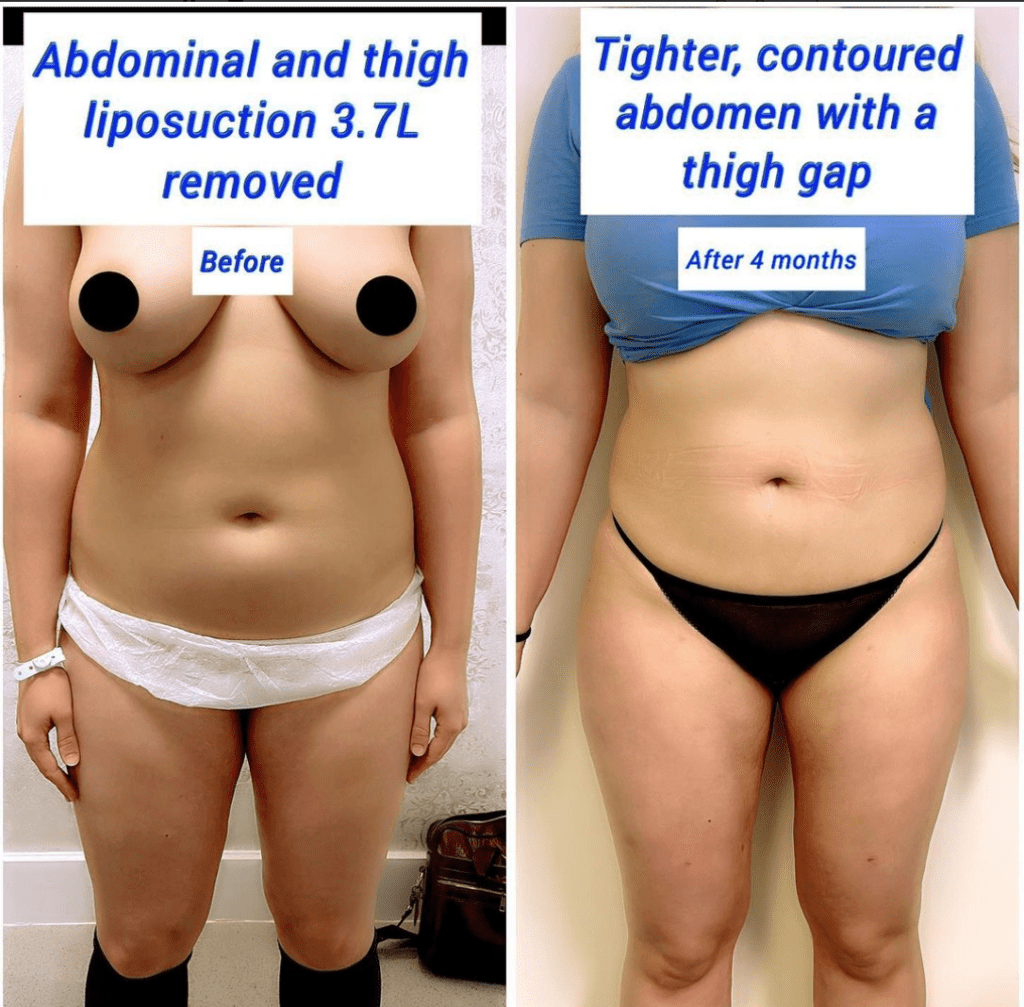After successfully losing a significant amount of weight, it’s common to be left with excess folds of skin. This stops you from appreciating the amount of work you have put in to lose weight. Loose skin not only affects your confidence but can cause functional problems and skin irritation. A lower body lift can remove excess skin while at the same time lifting the buttocks and improving the contours of the body. Before going ahead with this surgery, you need to understand the recovery timeline and how you can make the most out of your recovery period.
What is a Lower Body Lift?
There are no shortcuts to recovery; it takes time and patience for your body to heal. A lower body lift is a surgical procedure that involves removing excess skin and tightening the underlying muscles. It looks to improve the contours of the abdomen, thighs, buttocks, lower back, and flanks.
A lower body lift after weight loss targets excess skin that often comes with significant weight loss. What’s frustrating about losing a lot of weight is that you can’t always see all your hard work when there is excess skin in the way. A lower body lift aims to remove excess skin and tighten the muscles.
Also known as a belt lipectomy, a lower body lift essentially extends a tummy tuck incision around the torso. It’s this longer incision that allows your incision to target excess skin in several areas including the buttocks and thighs. The precise length and pattern of the incision depend on your body and how much skin you’re looking to remove. Your plastic surgeon will make every effort to conceal your scar in your underwear or bikini. But the surgery does involve a long incision so this is something to keep in mind.
There are several reasons why someone chooses to undergo a lower body lift like:
- Significant weight loss through dieting
- Undergone bariatric surgery
- Have a lot of sagging skin on the lower part of the body
- Have a stable weight and expect no further weight loss
Lower Body Lift Recovery Timeline
Following your surgeon’s post-op instructions are key to a successful recovery. Generally, patients need at least 2 weeks off work to recover, with most having to restrict normal activity for 4-6 weeks. Having a clear understanding of the recovery timeline is crucial in deciding if a lower body lift is right for you.
It’s normal to experience swelling after your procedure and this can last for several weeks. Because the procedure is invasive, you will need 2 weeks before you can resume any normal activities. The first week is the most vital part of your recovery, so make sure to rest as much as you can.
After 3-4 weeks, a significant amount of swelling should have gone and you will be starting to feel more like your normal self again. As you start to resume normal activities, you will gradually see your results. It’s important that you speak with your doctor before resuming any heavy lifting.
Like any procedure, a belt lipectomy does have some risks. Lower body lift complications include, but are not limited to:
- Seroma
- Bleeding
- Bruising
- Infection
- Anesthesia risks
- Asymmetry
Lower Body Lift Scars After One Year
Your scars can take up to a year to heal, so patience is key. Because a lower body lift uses incisions on your hips, legs, and lower back, you will have some scarring in these areas. In most cases, lower body lift scars fade over time and will gradually get more noticeable.
Remember that scars are red and raised in the beginning. While scars should fade over time, they will likely never be invisible. After all, your doctor is making an incision during the procedure. It’s normal to be concerned about scarring with any cosmetic surgery. You should discuss this issue with your doctor as they may be able to suggest a less invasive yet effective procedure if possible.
Lower Body Lift Before and After

10 Lower Body Lift Surgery Recovery Tips
As you can see, it’s a surgery that involves multiple areas of the body. It’s a hugely transformative surgery that can have a massive impact on the way you look. The procedure is an extensive surgery, so it’s crucial that you understand that the recovery is pretty lengthy. It can take months to return to exercise at your previous level, depending on your surgery. Here are 10 lower body lift tips to help ease your recovery and maximise results.
1. Wear Your Compression Garment
One of the best things you can do for your recovery is to wear your compression garment. They are your friends. These garments help to minimise swelling and reduce bruising. At the same time, compression garments help prevent wound separation. Wear them as much as you can, and always listen to your surgeon’s advice.
2. Make a Plan
For the first 1-2 weeks, you will have considerably limited mobility. It’s essential that you plan ahead before your surgery. You will likely need help following your surgery in managing medication and performing daily tasks.
3. Be Patient and Relax
Although losing weight in itself is a long transformational process, you need to be patient in your recovery. In your recovery, try to relax and let your body heal. It’s a good idea to move a little and go for some light walking while recovering. This helps with the swelling and keeps everything in your body flowing as it should.
4. Stay Hydrated
Drink plenty of water throughout the recovery process. Water will help to minimise swelling and reduce pain. Drinking plenty of water helps to get rid of toxins and removes anaesthetic from your system more quickly. Hydration is also very important in wound healing.
5. Eat a Low Sodium and High Protein Diet
A diet high in sodium can increase swelling. At the same time, protein helps to stimulate healing. A combination of low sodium and high protein is the ideal recovery diet. Following your surgery, eat a healthy and balanced diet to support the healing process.
6. Elevate Your Position
It may be uncomfortable to sleep on your back in the beginning. Try elevating your legs with pillows under your knees to increase comfort and promote healthy circulation. Sleeping in an elevated position helps to reduce swelling. Some patients find that sleeping in a recliner is more comfortable in the initial stages of recovery.
7. Get Moving
It’s important that you get moving after your surgery. That doesn’t mean go for a run. Instead, try to do light and short walks around the house to promote good blood circulation. You will need to walk with a slight bend in your upper body to avoid putting too much pressure and tension on the surgical site.
After about a week, you can start taking short walks of about 10-15 minutes if you feel up for it. You can have a couple of walks each day, depending on how sore or how swollen you are during your recovery.
8. Be Realistic
Be realistic in your expectations of recovery. It takes time to heal. That means not jumping back into work too quickly or trying to move too much too early on in your recovery. Prepare for your recovery and keep in mind that it will likely be uncomfortable, fairly long, and frustrating at times. A lower body lift is a significant surgery and your body will need time to get back to normal.
9. Scar Care
Your doctor will speak to you about scar management. Typically, once your incisions are healed you can start to think about scar management and minimising scars. Silicone strips, tape, or gel, can help to encourage scars to heal nicely. Usually, scar management will continue for a few months after your recovery.
10. Avoid Driving
As a lower body lift targets your lower body, driving will be out of the questions for a little while. It’s strongly discouraged to drive for a few weeks after your surgery. Stiffness, pain, and general discomfort can make driving more dangerous. If you’re taking strong painkillers, this could impact your concentration on the road as well.
A lower body lift can allow you to finally benefit from your efforts to lose weight. Excess skin not only affects your confidence but can cause physical issues. If you think a lower body lift is suitable for you, always speak to an expert plastic surgeon who can tell you everything you need to know. That way, you can make the best and most informed decision.
A suitable candidate for a lower body lift has finished their weight loss journey. They are at a stable and healthy weight but are struggling with excess skin. Whether you lost weight through bariatric surgery or diet and exercise, it’s an ongoing challenge.
If you’re considering a lower body lift, contact the team at the Harley Clinic on Harley Street to talk about your options. Your cosmetic surgery consultation is a great place to ask plenty of questions and feel completely confident in your plastic surgeon.













